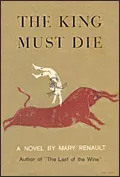Mary Renault’s first foray into the realm of Greek legend is The King Must Die, a retelling of the tales handed down about Theseus. Her recreation of Theseus’ early life is an enthralling first-person story of a young man on a quest from obscurity to kingship; those who know their Greek myths may remember him from the legend of the Minotaur. Renault offers believable versions of his varied adventures, avoiding the overtly supernatural. Her great accomplishment is the recreation of the starkly different mindset of the world in which the stories take place. She sees the late Mycenaean Age as a time of transition. Crete rules the Aegean, but the smaller realms on its periphery are barely emerging from the stage of human development when kings were sacrificial figures, cut down for the sake of the kingdom’s future when their term ended. She shows a culture that is also shifting from a matriarchal religion to one in which male gods predominate.
These rich themes give the novel its weight and texture, but the core of the tale is a great adventure that combines popular genres of heroic resistance and rebellion with those of the sport novel. Renault melds the original legend of sacrificial victims and a deadly labyrinth with the images of acrobatic bull-leaping found in Minoan art. Theseus’ triumph in the Knossos of King Minos is linked to the evergreen story of a group of young people forged into a team in order to triumph in an athletic event. The King Must Die was the first Renault novel I ever read, and thanks to its blend of vivid action and the artful evocation of a very different culture it remains my favorite. (1958, 332 pages)





